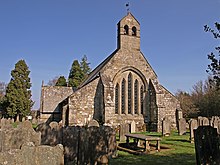| Simonburn | |
|---|---|
 | |
Location within Northumberland | |
| Population | 192 (2011) [1] |
| OS grid reference | NY875735 |
| District | |
| Shire county | |
| Region | |
| Country | England |
| Sovereign state | United Kingdom |
| Post town | Hexham |
| Postcode district | NE48 |
| Police | Northumbria |
| Fire | Northumberland |
| Ambulance | North East |
| UK Parliament | |
Simonburn is a small human settlement in Northumberland, England.

